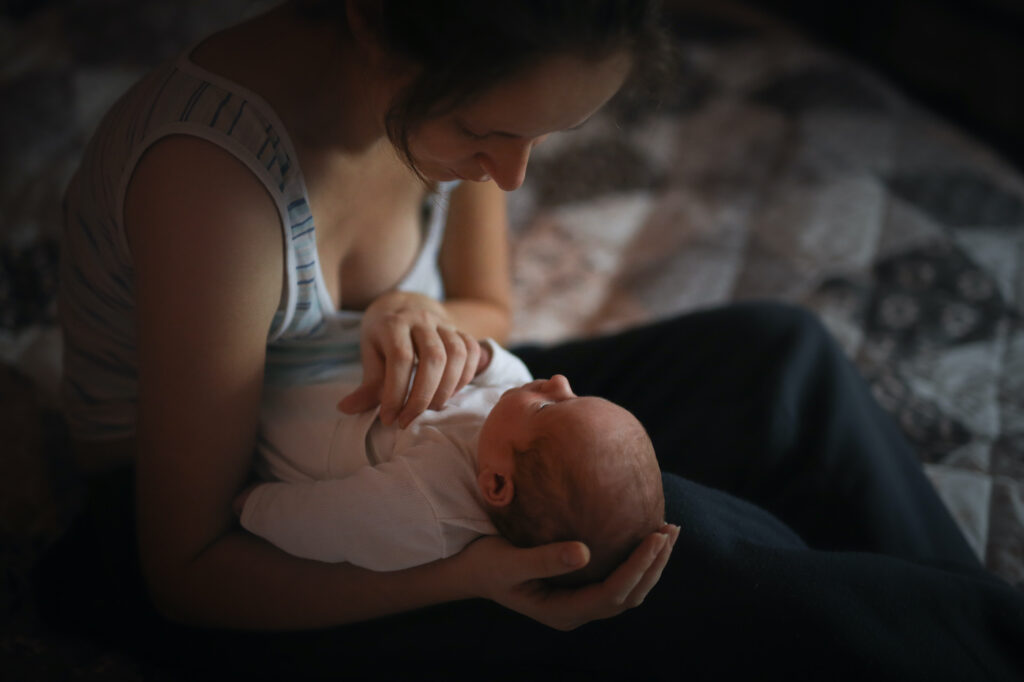Few experiences for women are as universal as motherhood, and yet rarely will you see its intricacies discussed in detail. “Has there ever been a description in literature of what it entails to change an infant’s diaper?” Szilvia Molnar asks in her debut novel, The Nursery, a book about one woman’s journey through the first magical and terrifying postpartum days.
If you listen to the critical reception, Molnar “paints an honest, frightening and claustrophobic picture of new motherhood” (New York Times). The book gives “a fuller and more nuanced picture of the experience of new motherhood, which doesn’t always live up to the insistently rosy portrait we have of it” (The Atlantic).
But when Molnar’s protagonist struggles to leave her apartment at all and finds herself googling “How common is wanting to kill your baby?” is this really a depiction of motherhood in general, and is this the portrait that we want to paint for new and future moms?
The Nursery is a quick read, but it feels much heavier than its 184-page length. At the start, anyone who has ever borne a child will relate to its contents: from the incisive description of the simple process of using the restroom (now involving mesh underwear, squirt bottles, and instructions to pat, not wipe), the pain and the constancy of nursing, and the brain fog that reduces your vocabulary to that of a first grader.
Start your day with Public Discourse
Sign up and get our daily essays sent straight to your inbox.Molnar’s unnamed protagonist has just had her first child (“a leech, let’s call her Button”) with her husband, John. The child is more an object, or rather an obstacle, than a new member of the household. “When I’m able to put her aside, I move Button away from me like an item,” the protagonist muses.
Molnar’s tone may seem incredibly harsh to anyone who hasn’t been through the trenches of new parenthood; to those of us who have, only slightly so. But as much as The Nursery has perhaps the rawest descriptions of new motherhood ever put to paper, and I found myself relating to so much of it, it also left me feeling hopeless—in fact, even more hopeless than I ever felt in my own early postpartum days.
A woman who has just given birth even under the best of circumstances is bound to feel battered. But she should feel more like a soldier returning victorious from war.
Because while I at least had the comfort of a tiny, snuggly being to mitigate the intensity of the sleep deprivation, the enormous responsibility, and the perineal pain, The Nursery’s narrator has little positive to say about her newborn daughter—or about herself. After giving birth, she is “like what you see scattered along a highway, an item once of value. I was a can of soda, a sock, a half-smoked cigarette, a piece of gum, a headless toy, a pair of used underwear.”
A woman who has just given birth even under the best of circumstances is bound to feel battered. But she should feel more like a soldier returning victorious from war. She isn’t an item that is broken or used up; she is a champion whose stretch marks, stitches, or perennial tears are her battle scars.
Pace the glowing reviews of The Nursery—which I won’t besmirch by saying it’s a bad book, because I don’t think it is—this novel isn’t generally about motherhood, or postpartum, or what women experience when they meet their newborns. It’s about one woman’s specific experience of postpartum depression and anxiety. In fact, postpartum depression was “one of the main themes I wanted to explore in the book,” according to the author. Neither should we conflate Molnar with her narrator; this is a novel, not a memoir. And Molnar herself clearly found motherhood somewhat satisfying; she started writing the book in the throes of postpartum with Baby #1, and she finished it after giving birth to Baby #2.
Molnar does say, however, that “making the distinction between my craft and my real life was becoming impossible, but pulling the two apart would perhaps also hurt both worlds.”
While many women will find that the early postpartum days are some of the most harrowing of their lives—I certainly felt this way—I hope that most of us find the extremeness of Molnar’s protagonist’s experience to be alien.
After page upon page of the protagonist’s bemoaning her loss off identity, googling terms like “postpartum anxiety” and “postpartum OCD,” and imagining herself smothering her child or chucking her out the window, the novel ends on a literal light note, as our antiheroine finally joins her husband and infant in stepping outside the apartment: “The golden hour reflects off our skin and I am reminded: it is my favorite time of the day.”
While many women will find that the early postpartum days are some of the most harrowing of their lives—I certainly felt this way—I hope that most of us find the extremeness of Molnar’s protagonist’s experience to be alien. There is certainly nothing wrong with an author’s exploring the darkness of the human mind, and, in fact, some of the greatest literature has come from it. But I do worry that some may see The Nursery as indicative of motherhood in general—and find themselves scared away.
In the conclusion of the New York Times’ review of The Nursery, author Claire Dederer muses, “As I considered the sheer ordinariness of the narrator’s circumstance, I began to wonder: Is this the tale of something diagnosable, something we put in a file named ‘postpartum depression’? Or is it simply an honest rendering of a transformation that would make all of us unrecognizable to ourselves, if only we sat with the truth, as Molnar has done here?”
If anything, however, Molnar’s protagonist exists in extraordinary circumstances, ones that have social and political implications for a society that wants to support new mothers. The protagonist’s mother died when she was young; she lives in a big city with her husband and has no support network. When a handful of visitors drop by after the birth, they are described as “mostly from John’s world,” and some she knows from her work.
She spends her days in isolation—save for a widower upstairs whose random visits become her lifeline—as her husband immediately returns to work after the birth. From this, we can draw social imperatives; the protagonist’s experiences would have been vastly different with a large and supportive community network, such as one found through church or neighbors. This has policy (or at the very least, private sector) implications, too: John has no prolonged paternity leave, meaning that when he goes back to work shortly after the baby’s birth, she and her mother are left with no help.
When I gave birth to my first child last year, my parents stayed in town for two weeks. My husband, thanks to his government job, took three months of paternity leave, cooking and tidying while I was healing from second-degree tears and stuck in contact naps. We were blessed with a community of friends, church members, and neighbors who delivered meals and offered other forms of support. Who knows what my mental state would have been if I hadn’t had so much help in the beginning?
Had I read The Nursery a year and a half ago, before I bore my son, it would have filled me with terror. Reading it now (during 1.5-hour spurts while my toddler napped), I found it merely melancholy, and somehow the protagonist’s descriptions of her baby’s helplessness and neediness made me nostalgic for that physical closeness that only exists between a mother and her child during those first few months of life. I wouldn’t recommend The Nursery to anyone who has not yet had a child but plans to.
“It seems like every literary or journalistic depiction of motherhood these days is dark . . . and somehow always elicits ample praise for being brave and truth-telling,” tweeted writer Elizabeth Nolan Brown in response to the Times’ review of the book. “I’m all for society sugarcoating motherhood & parenthood less, but . . . it feels like we’ve slipped into a weird pathology in certain circles where all people do is warn about how miserable it is & the only accounts accepted as truths are litanies of never-ending hate & terror & pain.”
Yes, giving birth to a child will leave you sleep-deprived and emotional and physically scarred. That’s only half of the story.
The National Marriage Project’s Brad Wilcox agreed, adding that despite the popular narratives, mothers are, empirically, doing pretty well: “You’d never know from most media accounts of contemporary motherhood that—on average—mothers are more satisfied [with] their lives than their childless peers,” he wrote.
As Alexandra Davis recently wrote for Public Discourse, “We don’t need to keep reminding women that motherhood is hard.”
If The Nursery is a tale of motherhood, it is only a half-truth. Yes, giving birth to a child will leave you sleep-deprived and emotional and physically scarred. That’s only half of the story. The other half is that you’ll wake up one morning and realize that your newborn is smiling at you (and no, it’s not just gas). You’ll feel him grasp your face and look deeply into your eyes. You’ll see her bring so much joy to your spouse. You’ll watch him fall asleep on your chest and know a contentment you didn’t think was possible. The lows are low. But the highs are so, so high.
“I think about how I am going to resent you once you arrive,” the protagonist muses before her child is born. “You will disrupt the peace. You will get in the way of my freedom.”
This is true. My husband and I joke that our energetic son has not known a moment’s peace in his entire life. I miss not having to plan my social life around a little one’s sleep schedule. The identity shift and the feelings that Molnar’s protagonist wrestles with are real. But so is the deep, deep love between a mother and child. And if our literature has been lacking in descriptions of diaper changes, it ought to tell the full story: that of the mundane, the ugly, and the beautiful.














